Optical parametric oscillators offer a competitive alternative to conventional lasers for molecular physics and quantum nanophotonics.
By Jaroslaw Sperling and Korbinian Hens
A considerable part of contemporary photonics research that investigates the interaction of light with nanoscale objects — nanophotonics — is motivated by the commercial potential of real-world devices. A vast number of experimental studies call for high-quality, continuous-wave (CW) laser light that is tunable throughout the visible spectrum, but it is not straightforward to cover this region with most common tunable laser designs. Alternative sources based on CW optical parametric oscillator (OPO) technology have become commercially available relatively recently and are quickly gaining popularity.
Principles of OPOs
OPOs might be considered light sources that deliver coherent radiation very similar to lasers, but there are two main differences1. First, the OPO principle relies on a process referred to as parametric amplification in a nonlinear optical material, rather than on stimulated emission in a particular gain medium; second, OPOs require a coherent source of radiation as a pump source, unlike lasers, which might be pumped with either incoherent light sources or sources other than light.
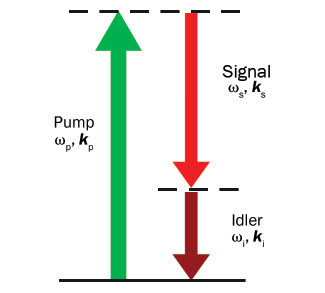
Figure 1. Schematic of the parametric process in OPOs. The process can be perceived as the splitting of an incoming pump photon of high energy into two photons of lower energy (typically denoted as signal and idler); it is subject to the conservation principles of photon energy (ωp = ωs + ωi) and photon momentum (kp = ks + ki + Δk). Courtesy of Hübner Photonics.
The basic scheme common to OPOs is illustrated in Figure 1. Simply speaking, the process can be perceived as splitting an incoming pump photon of high energy into two photons of lower energy, usually referred to as signal and idler photons, respectively. The overall process is subject to the conservation principles of photon energy and photon momentum (phase-matching condition), but it otherwise does not entail further fundamental restrictions, at least in theory. The huge potential of OPOs thus derives from their exceptional wavelength versatility, because they are, in principle, not limited by the wavelength coverage dictated by the energy levels and suitable transitions in a laser gain medium.
In practice, the OPO concept was experimentally demonstrated more than half a century ago2, but the progress in development and commercialization of turnkey devices has been stalled substantially by several technical obstacles3. These obstacles have been easier to overcome at the high peak powers of pulsed devices, and thus tunable OPOs operating in pulsed mode have become readily available from a variety of suppliers. Only recently have there been comparable advancements in CW OPO technology, which, in turn, have spurred the development of commercial systems 3.
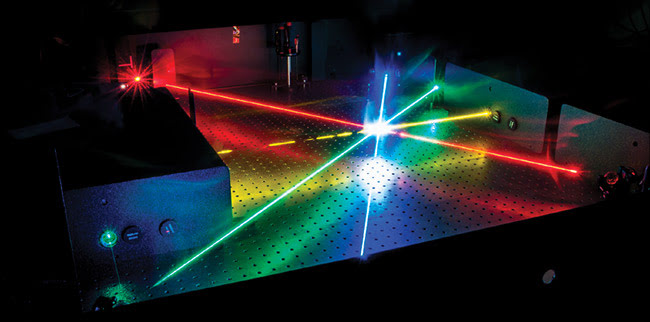
Optical parametric oscillator (OPO) technology provides laser light that is widely tunable across the visible spectrum. Courtesy of Holger Kock/Fraunhofer Institute for Physical Measurement Techniques IPM.
Progress has been mainly driven by the availability of cost-effective, high-performance CW pump lasers, along with the increasingly sophisticated design of new nonlinear crystals. As to pump lasers, the operation of CW OPOs puts stringent requirements on potential light sources in terms of preferential single-mode operation, noise characteristics, beam quality, and beam-pointing stability. Depending on power requirements, the end user can typically utilize either high-performance, diode-pumped solid-state (DPSS) lasers (for lower powers) or fiber-laser-based solutions (for higher powers). As to nonlinear materials and recent crystal design techniques, the emergence of quasi-phase-matched nonlinear materials, such as periodically poled lithium niobate (LiNbO3), whose crystal structure alters with a certain periodicity, have been very useful for the design of practical optical parametric devices.
Practical design, performance
OPO technology is ideally suited for generating tunable CW laser light across arbitrary wavelength ranges, but its process always generates output at wavelengths longer than those used for pumping. Consequently, OPO devices operating across the visible spectrum require either UV pump sources or additional frequency-conversion stages. As of today, only the latter approach has proven to be technically practicable and operationally stable in commercial turnkey systems.

Figure 2. Schematic beam path inside a commercial CW OPO system (see reference 4). In a first step (OPO), a 532-nm laser pumps a nonlinear crystal to generate signal and idler photons (900 to 1300 nm). Wavelength selection and subsequent second-harmonic generation (SHG) converts either signal or idler photons into the visible range of the spectrum — 450 to 650 nm. Pump laser beam (green arrow); signal beam (dark red); idler beam (arbitrary assignment) (light red). Courtesy of Hübner Photonics.
The essential building blocks of a commercially available tunable CW OPO4, designed to cover the visible range, are shown in Figure 2. The operational principle relies on a cascaded sequence of nonlinear optical processes within two cavities, referred to as OPO and SHG (second-harmonic generation).
Pump laser photons are first split into pairs of photons of lower energy — signal and idler (Figure 1). The OPO scheme employed is commonly referred to as singly resonant OPO cavity design. For a particular operational wavelength of the entire system, the cavity is operated “on resonance” at either a particular signal wavelength or a particular idler wave-
length. Thereby a precisely moveable stack of periodically poled nonlinear crystals allows broad wavelength coverage — for a particular wavelength selection, a crystal layer with a suitable poling is automatically selected, and its poling period further adjusted through a temperature-control loop. At the same time, the effective OPO cavity length is actively stabilized to a multiple integer of the selected operational wavelength.
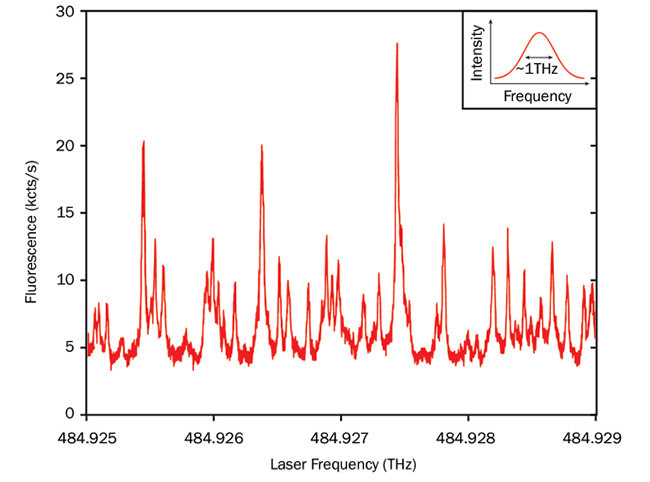
Figure 3. Excitation wavelength-dependent fluorescence intensity of dibenzanthanthrene (DBATT) molecules hosted in a naphtalene crystal at cryogenic temperature (see reference 6). The spectrum is recorded for a modehop-free scan over 4 GHz at a center wavelength of 618 nm. kcts/s: kilocounts per second. Courtesy of Tobias Utikal (Nano-Optics Group of the Max Planck Institute for the Science of Light).
While one of the generated (signal or idler) waves is circulating resonantly inside the OPO cavity, its counterpart can be extracted for wavelength conversion into the visible by another nonlinear process. As illustrated in Figure 2, this wavelength conversion takes place in a second, separate cavity by frequency doubling the primary OPO cavity output — the SHG process. Though this configuration is technically practicable and provides favorable operational stability, it should be noted that alternative designs, such as intracavity frequency doubling, have been successfully demonstrated in the lab1,3,5.
In Figure 2, the typical CW OPO device encompasses continuous tunability across the range of 450 to 650 nm, delivery of high-quality laser light output with a typical linewidth of <500 kHz, and generation of output powers in the range of several hundreds of milliwatts. Notably, long-term frequency stabilities as good as ±1 MHz over 10 hours have been demonstrated when operating CW OPOs in closed-loop mode, in conjunction with external wavelength measurement devices4. Though the particular CW OPO design shown in Figure 2 has been optimized for pump laser wavelengths
of 532 nm (in its commercialized version), the layout is generic enough to accept different pump wavelengths. These can be exploited to shift the overall wavelength coverage while keeping the same design principle.
Tunable OPOs at work
Not surprisingly, the sweet spots for implementing CW OPO technology are experimental settings that require narrow linewidths and significantly benefit from the accessibility of a wide tuning range, but are not too demanding in terms of output powers. Several examples are described below in an illustrative manner. Notably, the particular systems presented here are to be clearly distinguished in terms of the underlying physical phenomena that determine their spectroscopic signatures. However, in a broader perspective, all of the experiments are sensitive probes of nanoscale factors governing the light-matter interaction.
The fluorescence excitation spectra of single molecules can be demonstrated in a solid-state crystal at cryogenic temperatures6 (Figure 3). Under such conditions, individual molecules can be regarded as nearly ideal two-level systems with natural linewidths typically in the range of 10 to 50 MHz. Because of imperfections of the local surrounding crystal matrix, their transition energies are inhomogeneously distributed over a much wider spectral range. In the experimental data shown in Figure 3, the measurements unambiguously reveal several narrow spectral features within a scanning interval of 4 GHz, corresponding to individual molecules. It is further possible to lock the OPO wavelength in closed-loop mode to a selected single-molecule resonance for investigating its properties on an individual level.
There is a series of photoluminescence excitation spectra of so-called color centers in diamond that can be demonstrated at room temperature7 (Figure 4). Color centers are local defects (vacancies) in the diamond lattice related to impurities, and they have gained considerable attention over the last decade — not least as potential single-photon emitters, which are the heart of many promising quantum technologies such as quantum computing and quantum cryptography. Understanding the internal energy-level structure is of fundamental importance for future applications. CW
OPO technology has enabled the spectroscopic characterization over a broad wave-length range (460 to 650 nm) at sufficiently high excitation intensities.

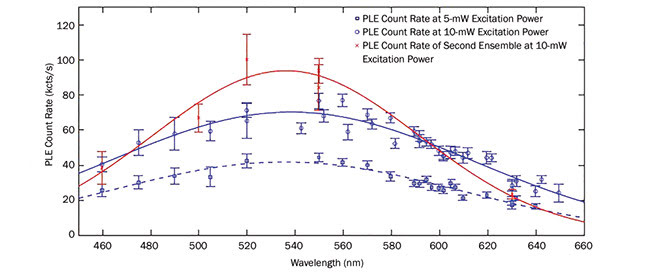
Figure 4. Photoluminescence excitation (PLE) spectra of a color center ensembles in diamond at room temperature (see reference 7). The data is recorded at different excitation powers across a series of excitation wavelengths between 460 and 650 nm. Blue squares and circles show measurements at 5 mW and 10 mW (respectively) of excitation power of one and the same ensemble. Red I-bars refer to measurements at 10-mW excitation power of a second ensemble. kc/s: kilocounts per second. Courtesy of Alexander Kubanek/Hybrid Quantum Systems Group at Ulm University.
A series of excitation energy-dependent Raman spectra of a mixture of single-wall carbon nanotubes (SWNTs) in ethanol solution can be seen in Figure 5. A carbon nanotube can be perceived as a strip of a graphene sheet rolled up into a cylinder along a chiral vector that is indexed by pairs of integers (n,m) and that determines its microscopic structure — tube diameter and the chiral angle along the tube axis. For characterizing the microscopic structure of SWNTs experimentally, Raman scattering is recognized as one of the main techniques8. Thereby, the most prominent signatures are radial breathing modes (RBMs), which correspond to collective movements of carbon atoms in the radial direction and are intimately linked to the SWNT diameter.
The usual Raman scattering signal is typically too weak to be of practical relevance. However, the Raman scattering efficiency is significantly enlarged if the laser energy matches the energy of optically allowed electronic transitions, an enhancement process referred to as resonance Raman scattering. For a particular laser excitation wavelength, the Raman signal from a mixture of SWNTs derives only from a particular subset that is in electronic resonance with the laser excitation. By systematically recording resonance Raman scattering spectra under continuous tuning of the excitation wave-length, in addition to subsequent comparison of the observed RBM frequencies with literature values, it is possible to assign the various (n,m) SWNT species present in a mixture. Figure 5 illustrates such an assignment of different tube species that are present in an ethanol solution.
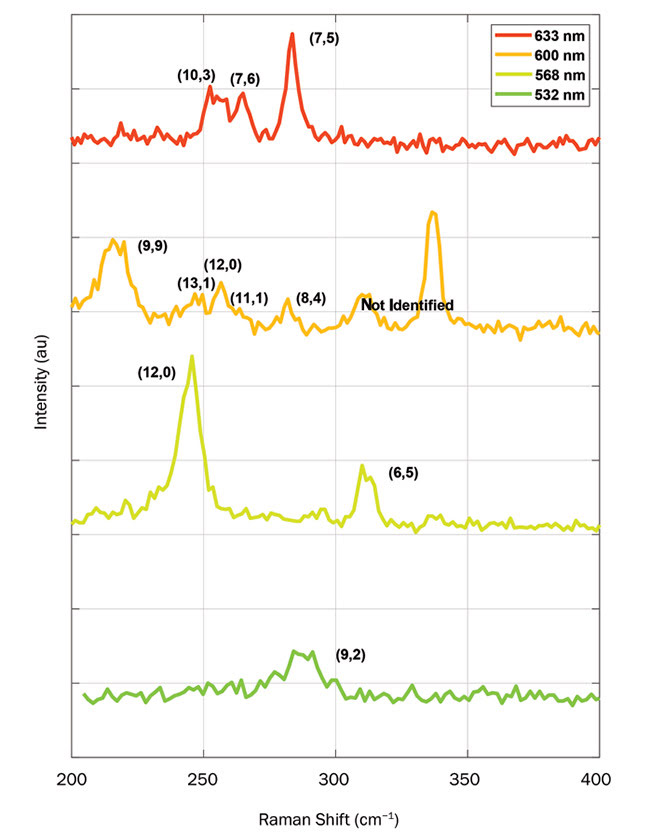
Figure 5. Resonance Raman scattering spectra of a mixture of single-wall carbon nanotubes (SWNTs) in ethanol solution (concentration of 1 g/l). The spectra are recorded for excitation wavelengths of 633, 600, 568, and 532 nm (top to bottom). The peak indices in parentheses (n,m) indicate the assignment of signals to SWNT of a particular chirality. Courtesy of Patryk Kusch/Stephanie Reich group. Free University Berlin.
Their performance characteristics make tunable CW OPOs competitive alternatives to conventional lasers and related technologies for the generation of widely tunable CW radiation in the visible
spectral range. This particularly applies for a variety of experimental studies in molecular physics and quantum nano-photonics. We can predict further applications, whether in the form of refining and extending the experiments presented here to new samples, such as photoluminescence studies of novel types of single-photon emitters, or in the form of increasingly sophisticated experimental approaches such as state-of-the-art methodologies in Raman scattering of single molecules.
Meet the authors
Jaroslaw Sperling is sales manager for HÜBNER Photonics. He joined the company in 2016, bringing experience gained in various sales and marketing-related roles across photonics research and industry. With a solid background in laser spectroscopy, he received a doctorate in physical chemistry from the University of Vienna.
Korbinian Hens is product manager for HÜBNER Photonics, which he joined in 2015, and specializes in terahertz spectroscopy and tunable laser systems based on OPO technology. With a background in laser-induced fluorescence spectroscopy for atmospheric research, he has a doctorate from the Max Planck Institute for Chemistry in Mainz, Germany.
Acknowledgments
The authors gratefully acknowledge the support of Tobias Utikal (Nano-Optics Group of the Max Planck Institute for the Science of Light), Alexander Kubanek (Hybrid Quantum Systems Group at Ulm University), and Patryk Kusch (Stephanie Reich group at the Free University Berlin).
References
1. R. Paschotta (2008). Optical parametric oscillators. In Encyclopedia of Laser Physics and Technology, 1st ed. Berlin: Wiley-VCH.
2. J.A. Giordmaine and R.C. Miller (1965). Tunable coherent parametric oscillation
in LiNbO3 at optical frequencies. Phys Rev Lett, Vol. 14, Issue 24, p. 973, doi:10.1103/PhysRevLett.14.973.
3. M. Ebrahim-Zadeh (2001). Optical Parametric Oscillators. Handbook of Optics, 2nd ed., chap. 22, doi:10.1109/CLEOE-IQEC.2013.6802014.
4. J. Sperling and K. Hens (2018). Made Easy: CW laser light widely tunable across the visible. Optik & Photonik, Vol. 13, Issue 3, pp. 22-24, doi:10.1002/opph.201800022.
5. R. Sowade et al. (2013). CW laser light tunable from blue to red: OPOs pave the way. Photonik International, pp. 63-65.
6. T. Utikal et al. (2016). Single molecule spectroscopy using C-WAVE. Optik & Photonik, Vol. 11, Issue 5, pp. 54-55, doi:10.1002/opph.201690073.
7. S. Häußler et al. (2017). Photoluminescence excitation spectroscopy of SiV- and GeV- color center in diamond. New J Phys, Vol. 19, pp. 1-9, doi:10.1088/1367-2630/aa73e5/meta.
8. C. Thomsen and S. Reich (2007). Raman scattering in carbon nanotubes. Top Appl Phys, Vol. 108, pp. 115-232. Holger Kock/Fraunhofer Institute for Physical Measurement Techniques IPM.